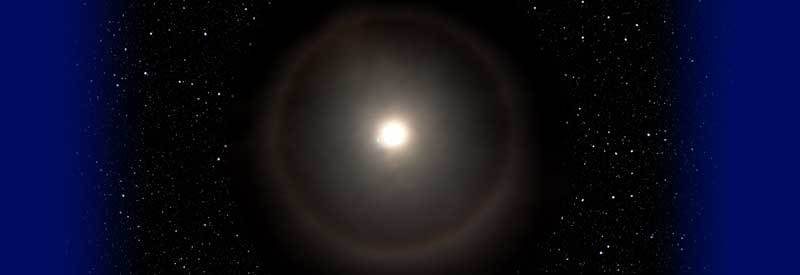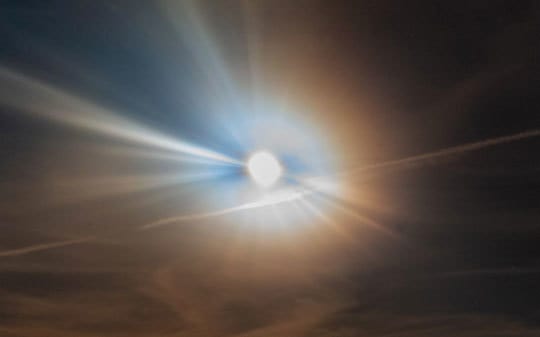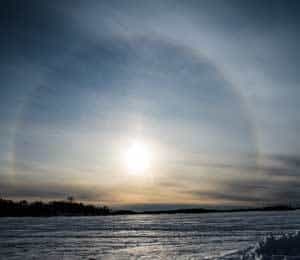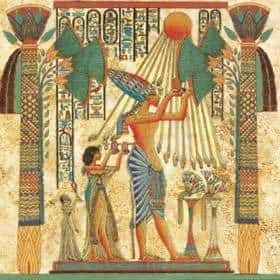Defining A Lunar Halo: Explaining The 22-Degree Halo Meteorological Phenomenon

Under certain conditions, observers will notice what seems to be a hazy-looking ring around the Moon in the evening. We take a closer look at this phenomenon, better known as a lunar or 22-degree halo.
A Lunar Halo, or 22-Degree Halo, is defined as a hazy ring that occurs around the moon at a radius of approximately 22 degrees. It results from the moon's light being refracted by ice crystals in Cirrus clouds in the upper troposphere at an altitude of approximately 6000 meters or 20 000 feet.
Although there are many theories and folklore surrounding this "supernatural" occurrence, very few people really know what exactly these rings (or halos) are or how they are formed.
In this article, we take a look at what these rings are and how and how they are created. We also address a few common assumptions and look at some folklore surrounding these mystical objects in the sky.
What Is The Ring Around The Moon?
A brief description of what these sometimes mysterious-looking rings around the moon has already been provided. To better understand its formation, though, one needs a more elaborate and detailed definition.
What Is A Lunar Halo?

A Lunar Halo, or 22-Degree Halo, is defined as a hazy ring that occurs around the moon at a radius of approximately 22 degrees. It results from the moon's light being refracted by ice crystals in Cirrus clouds in the upper troposphere at an altitude of approximately 6000 meters or 20 000 feet.
A lunar halo goes by many different names. Sometimes it is simply referred to as "the ring around the moon." In the scientific community, it is known as a 22 degree halo but is also known as a halo, moon halo, moon ring, or winter halo.
The hazy rings appear at a radius of approximately 22 degrees around the moon & vary from rainbow-colored to a pale white color, depending on the level of refraction, size of the clouds & strength of the moonlight.
It occurs in the upper troposphere, where temperatures are too low for water droplets to remain in its liquid form. The hexagon shape of the ice crystals breaks the moonlight up and refracts back to Earth.
The color of a lunar halo varies from a faint rainbow color to a pale white tint. The rainbow colors are the result of the ice crystals breaking up the white light into its primary colors. Sometimes, though, the primary colors combine and blend together to form a white tint.
The halo is not visible to everyone. It all depends on your geographical location in relation to the position of the moon. Depending on where you stand, the ice crystals will refract the light from the moon just at the right angle in order to see the circular-shaped phenomenon.
A lunar halo is exactly the same phenomenon that occurs during the daytime around another celestial body. The halo you see around the sun is the same meteorological phenomenon. Instead of moonlight, though, it is sunlight that is refracted in this case.
What Causes The Rings Around The Moon
As mentioned in the previous section, the rings you see around the moon result from the ice crystals in cirrus clouds refracting and reflecting the light in such a way that you can see a ring appearing from your location on the planet's surface.
A few things need to be in place in order, though, to observe these rings surrounding the moon clearly.
- The presence of a full moon is ideal for the best viewing conditions.
- 2Secondly, a clear sky with only a thin layer of cirrus clouds high up in the atmosphere is essential. (The presence of thicker clouds lower down in the atmosphere will obscure or eliminate the effect.)
- 3As the light from the moon (or sun) hits the cirrus cloud, it gets refracted and "bend" by the ice crystals. The refraction by the ice crystals causes the light to be projected somewhere else.
- 4If the light is refracted or "bend" at a certain angle, specifically 22 degrees, the rings will become visible to the observer. (This also means the rings have a radius of about 22 degrees around the moon or sun.) That is why this occurrence is also referred to as 22 degree halos by scientists and meteorologists.
As already mentioned, an individual also has to be in the right geographical location on the planet's surface )in relation to the moon's location) to observe this phenomenon.
Characteristics Of The Rings Around The Moon
A notable feature of the halo surrounding the moon is the lack of a clear and well-defined border. The fuzzy border is partly the result of so many millions of ice crystals refracting the light in multiple directions that it makes it impossible to create a well-defined border.
Although the ring around the moon has a mostly hazy white color, other colors can also be observed. This a direct result of the hexagon shape of the ice crystals.

Very much like the shape of raindrops causing the different colors in a rainbow to appear, the faceted (hexagon) shape of ice crystals not only refract the light of the moon but also breaks it up into its primary colors.
This is why you will occasionally notice some rings around the moon or sun to have a red tint on the inside and a blue tint on the outside.
Since the moon isn't as bright as the sun, the rings around the moon mostly appear white, while the rings around the much brighter sun more often display these rainbow colors.
Another interesting fact about the rings surrounding the moon is that the sky directly surrounding the ring/halo always appears darker than the rest of the night sky.
Finally, if you are lucky, you may catch a very rare glimpse of not one but a double halo surrounding the moon.
Folklore And Superstitions Regarding Rings Around The Moon
For centuries now and among many cultures around the world, a ring around the moon was a clear sign that rainy weather is on the way.
And to be honest, this is neither a myth nor a superstition. The presence of high cirrus clouds is very often an indication of wet and stormy weather on the way.
Cirrus clouds normally precede low-pressure systems by a day or two, and as many of you may already know, low-pressure systems are normally at the heart of stormy wet weather. (You can read more about low-pressure systems and cold fronts in this article.)
The most noteworthy part about specific beliefs and folklore concerning rings around the moon is the surprising lack of any specific ones.
Normally, different cultures and religions look to these celestial bodies and attach some significant meaning to changes in their appearances when it comes to the sun and moon.
Significant events like the Full Moon, New Moon, and especially rare events like Solar Eclipses (especially combined to cause a "Blood Moon"), all have significant meaning and are often a time for religious ceremonies and even sacrifice for some pagan religions.

The worshiping of the sun (and events surrounding the sun) is probably the oldest religion in the world and predates any recorded history. The worshiping of the sun gods Amun and Ra is well documented in ancient Egyptian history.
Celebrations of the winter solstice, symbolizing the victory of light over darkness, also predates any Christmas celebrations during the same period, celebrating the birth of Christ.
Yet, despite all these celebrations and importance given to various events surrounding the sun and moon by various religions and cultures over the centuries, there is no evidence (not even a mention in any literature) of any attention given to the halos surrounding the moon.
The biggest irony is that the only folklore surrounding the rings around the moon is based on actual science. And that is the belief that the hazy ring we see at night surrounding the weather symbolizes rainy weather. As it turns out, this belief is actually scientifically correct.
Conclusion
As you can clearly see, the visible ring/aura around the moon that sometimes occur under ideal conditions is not nearly as mystical as one might think.
There is a very simple scientific explanation for it, which has everything to do with what is going on in our atmosphere, and nothing to do with what is happening in space around the moon itself.
The multicolored rings we sometimes see around the sun is also exactly the phenomenon that occurs around the moon.
Never miss out again when another interesting and helpful article is released and stay updated, while also receiving helpful tips & information by simply clicking on this link .
Until next time, keep your eye on the weather!
